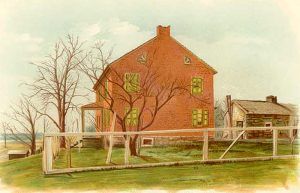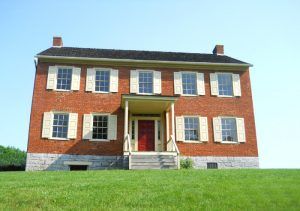Located on Warrior Run Creek, about four miles east of Watsontown, Pennsylvania, Fort Freeland was the site of a mill built by Jacob Freeland in about 1774.
In 1772, Jacob Freeland and several other men from Essex County, New Jersey, cut their way through the dense woods and settled with their families in the area. More families soon followed and lived on friendly terms with the Indians until 1777, when the tribes began to rebel. At this time, many of the settlers removed their families. However, in the fall of 1778, during the American Revolution, the men returned and stockaded the home of Jacob Freeland. The pickets enclosed Freeland’s sizeable two-story log house and enclosed a half acre of ground. That winter, several families moved into the fort.
In the spring of 1779, the men planted corn and were occasionally surprised by the Indians. However, nothing serious occurred until July 21, 1779, when some of the men working in the field were attacked by a party of Indians in the morning. Isaac Vincent, Elias Freeland, and Jacob Freeland, Jr. were killed, and Benjamin Vincent and Michael Freeland were taken prisoners. Ten-year-old Benjamin Vincent hid in a furrow, but he was also captured.
Nothing again occurred until the morning of July 29. At about daybreak, as Jacob Freeland, Sr. was going out of the gate, he was shot and fell inside the gate. The fort was surrounded by about 100 British troops and 300 Indians, commanded by Captain McDonald. In the Battle of Fort Freeland, there were only about 21 men in the fort who had little ammunition. At about nine o’clock a.m., a flag of truce was raised, and negotiations began. By noon, an agreement had been made that all who could bear arms would be taken as prisoners, the old men, women, and children set free, and the fort was given up to plunder. After the surrender of Fort Freeland, Captains Hawkins Boone and Samuel Daugherty arrived with 30 men, supposing the fort was still holding out. As they dashed Warrior Run, they were surrounded. Boone and Daugherty, with nearly half their force, were killed. The remainder broke through their enemies and escaped. Thirteen scalps of this party were brought into the fort in a handkerchief. Soon afterward, the fort was set on fire and burned down.
The effect of the fall of Fort Freeland and the desertion of Boone’s Fort was disastrous to the region and left Fort Augusta uncovered to the inroads of the enemy. In the meantime, Colonel Samuel Hunter, commanding Fort Augusta, had few men, and finally, in November, a German Battalion of about 120 men was sent to him. After securing Fort Augusta, he ordered his men to build Fort Rice and Fort Swartz and garrisoned both.
Years later, the Hower-Slote House was built on the site of Fort Freeland in 1829 by James Slote. Built in the Federal style, it was the center of a working farm for more than 125 years. It still stands today at Warrior Run Boulevard and Trent Road in Turbotville, Pennsylvania.
© Kathy Alexander/Legends of America, updated November 2022.
Also See:


